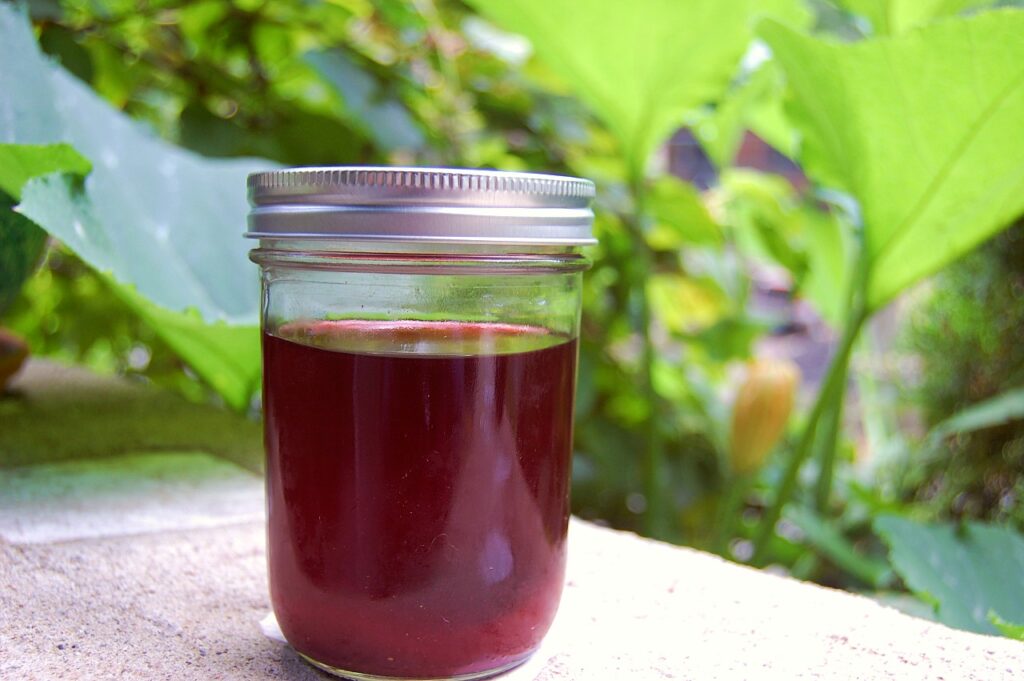
Shrubs, or drinking vinegars, are one of our favorite ways to preserve fruit. If you offer a houseguest a shrub they may be very confused as the word is more associated with garden topiaries than drinks these days, but shrubs were once a very popular beverage, especially during the American temperance movement of the early 20th century as an alternative to alcoholic drinks. The word shrub is derived from the Arabic sharab meaning “syrup,” but it seems to have originated as a beverage in 17th century England. Before the invention of refrigeration, it was common practice to preserve fruit in barrels of vinegar, where the acidity of the vinegar kept the fruit preserved for use when out of season. Sailors were said to have taken shrubs on board as a source of Vitamin C on long voyages. Though shrubs fell out of favor once access to refrigeration became widespread, they have recently made a comeback as an addition to craft cocktails.
Shrubs are a great way to preserve fruit when you don’t have the time or energy for canning. It’s also suitable for fruit that’s a little past its prime that you wouldn’t want to can anyway. I often make shrubs with the tail ends of a fruit crop, or after a foraging trip where I managed to grab a few handfuls of berries but not enough for a major cooking project. There are a few different ways to make shrubs, but at their core they all involve mixing fruit with vinegar and sugar. Some recipes instruct to add the sugar to the fruit first and then, after a couple days, strain out the resulting syrup and add vinegar. Others suggest adding the vinegar to the fruit first, then adding the sugar once the fruit has sufficiently infused into the vinegar. I recently tried both methods to make two strawberry-rhubarb-basil shrubs as a side-by-side comparison and found the final products to be virtually indistinguishable in taste. The vinegar-first shrub was a bit clearer than the sugar-first shrub, so keep that in mind if a crystal clear final product is important to you.
The Shrub making Process:
Selecting Your fruit
- Virtually any fruit will do, though I am partial to juicy berries. I have made delicious shrubs from cherries, currants, blackberries, raspberries, mulberries, strawberries, and peaches.
- As mentioned above, the fruit doesn’t have to be in perfect condition as it would in a canning recipe. Just wash your fruit well and discard any moldy ones, but soft, shriveled or damaged fruit is fine. Large fruits such as peaches, apples and pears should be roughly cut into chunks to provide more surface area.
Selecting Your Vinegar
- I usually use white distilled vinegar as it provides a very clear, neutral acidity. That being said, apple cider vinegar or wine vinegars can also be used and will provide interesting flavors to complement your fruit.
- Balsamic vinegar is also great in shrubs- one classic combination is strawberries, balsamic vinegar, and black pepper.
Adding Herbs and Spices
Herbs like basil and mint or spices like cinnamon and ginger can really amp up the depth of flavor in your shrub. This is where making shrubs gets fun for me, tinkering with different flavor combinations. The strawberry-rhubarb-basil combination I made earlier this year was an absolute winner, as was mulberry-lemon balm. Pear and peach with warm spices like ginger and cardamom are delicious in the Fall (and any time of year). There’s really no “rules” you need to follow for adding other seasonings to your shrubs other than a suggestion to try new combinations in small batches first to determine if you’ll like them. I usually add no more than a couple sprigs of herbs or Tbsp of spices per pint of fruit to avoid overwhelming the flavor.
Creating your Shrub
Now that you have your ingredients, the assembly is very easy. As I mentioned earlier, sugar-first or vinegar-first really comes down to preference, but here is how I typically make mine. In a nonreactive bowl I weigh my fruit. I then add about the same weight in sugar, sometimes less if it’s a particularly sweet fruit like mulberries. Using a fork, I mash the fruit and sugar together so the sugar draws out the fruit juices, then cover with a clean dish towel and let sit in the refrigerator for several days (or even more than a week if I am particularly busy). The fruit sugar mixture may start to ferment a little, which is fine! After several days I strain the fruit through a fine mesh sieve into a mason jar and add vinegar to roughly double the volume (so if I have a pint of sugar-fruit juice mixture I add another pint of vinegar). You can do less vinegar but you need a decent amount to keep the shrub preserved as it is rather than fermenting. I keep mine in the fridge, where it will last for months. They are absolutely delicious as an addition to cocktails or with sparkling water as a homemade soda.
